Text
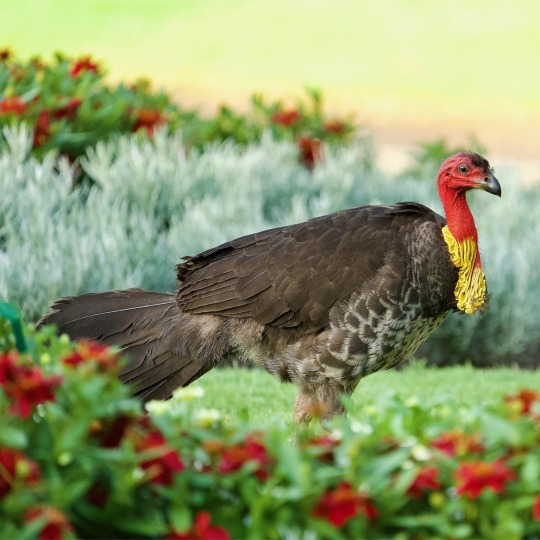
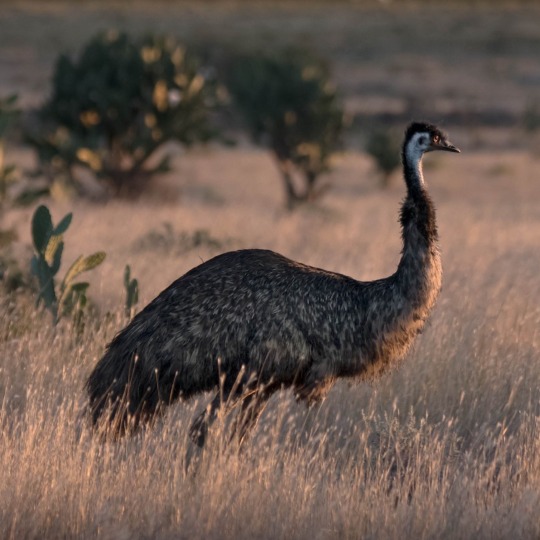
Remember to read about the contestants before voting!
Australian Brushturkey
With a beautiful little waddle, the Australian Brushturkey is actually not closely related to the Turkey! Another bird who survived the brink of extinction to live another day, they build huge nests in order to incubate their young. The temperature, regulated by the male Brushturkey by adding and removing material, can impact the sex of the hatched egg. At a certain temperature, the chance for male or female is 50%, but at colder temperatures females are more likely and vice versa. Learn More!
Emu
We all know of the Emu War… and if you don’t I would highly recommend looking it up. Back when Australia was first being used as a place to send prisoners, some farmers were having a hard time settling down due to the population of Emus already there. So began the emu wars. Armed with a shitty truck and a couple of guns, a few men went out to demolish the Emus. And of course… the Emu won! With their tough hides and the bumpy terrain, they were easily able to stand up against their attackers and take gunshot wounds in stride. Soon, with more Australians coming to the side of the emu, they eventually gave up their battle and the Emu lived on in their habitat. Learn More!
(Australian Brushturkey photo by Ken Wright) (Emu photo by Hayley Alexander)
114 notes
·
View notes
Note
can i pls get a b(r)ush turkey to honour the nest they made around the corner from my house...
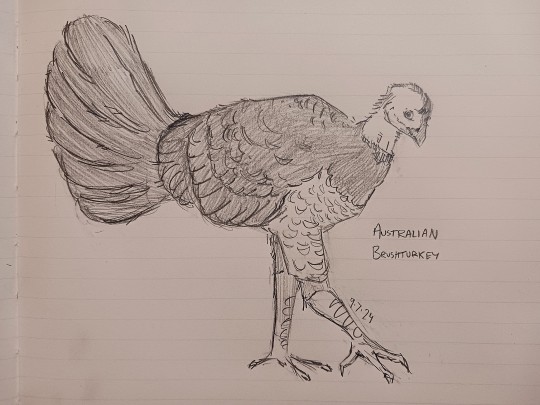
This guy was tough to draw 😭😭 but good practice!!
11 notes
·
View notes
Text

[447/10,977] Australian Brushturkey - Alectura lathami
Order: Galliformes Family: Megapodiidae (megapodes)
Photo credit: J J Harrison
125 notes
·
View notes
Text
Australian Brushturkey (Alectura lathami)
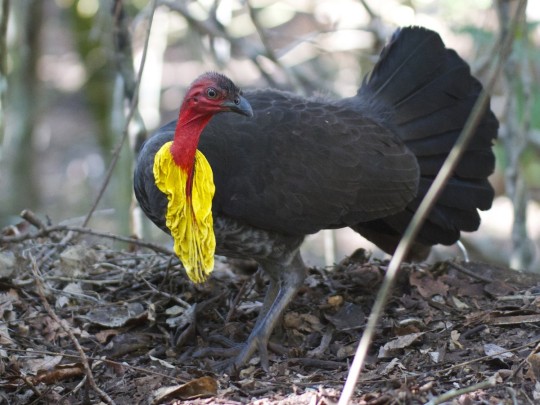
"They make huge piles of leaves and branches as nests. Once I saw a solitary male in a wildlife park and the keepers said he was really annoying because he kept re-arranging the leaf litter which made keeping the footpaths clean a huge pain lol!" "Small gardener-dinosaurs! And these guys are just out here existing with zero parental care."
"Despite its name and their superficial similarities, the bird is not closely related to American turkeys, nor to the Australian bustard, which is also known as the bush turkey."
Australian Brushturkey are a megapode found on the Eastern edge of Australia, typically living in rainforests or wet sclerophyll (eucalyptus-heavy) forests- though they've more recently been moving into cities such as Brisbane and Sydney.
As megapodes, the most unique feature of these birds is the way they incubate and "raise" their young- which is to say, they don't raise them at all! Megapodes are a family of birds that create mounds of rotting vegetation for their eggs to incubate within, much like crocodiles and alligators. The males will tirelessly defend their mounds, checking the temperature with their bills and doing their best to attract females to lay her eggs within. This is the only care they give their young, however. Brushturkey eggs are quite large, and their chicks are born precocial, or "fully developed". Unlike other precocial species, like chickens or ducks, megapode babies can fend for themselves within hours of hatching, and don't need parental guidance in order to make it in the world. Which is good news, since mom invests no care in her young and dad is only concerned with keeping his nest mound in perfect condition!
Sources:
Image Source: eBird (Chris Barnes)
#Alectura lathami#Australian brushturkey#Gweela#megapode#australian wildlife#Australian birds#megapodiidae#in memoriam (joke)
8 notes
·
View notes
Text

Australian Brushturkey (Alectura lathami), family Megapodidae, Eastern Australia
Photograph by Jan Wegener
2K notes
·
View notes
Text
24th of July 2024: Australian Brushturkey
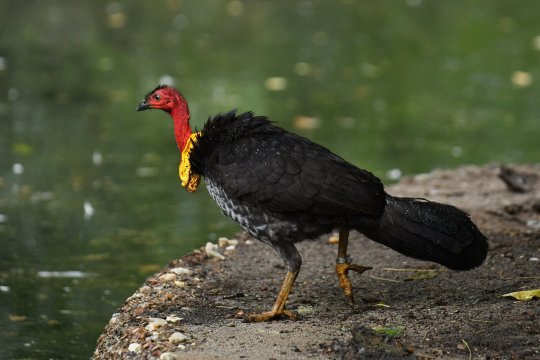
Here is a bird once described as an “enigmatic urban coloniser” [1]: the Australian Brushturkey (Alectura lathami). They’re one of Australia’s three megapodes and are 60-75 cm long [2].
Like many megapodes, they too do ground-nesting, brooding 50 eggs in a mound [2]. These mounds are prepared by the males, who may move up to 50 kg of earth daily to construct their nests [3], which are around 4m in diameter and 1 m high [2]. Once in place, Australian Brushturkeys follow a non-monogamous mating structure, wherein females will go from nest to nest to breed with the males and lay eggs in their mounds. This means the eggs of a previous male may end up in wrong nest, however it appears the males don’t really mind that much. In fact one male was even recorded taking over the mound of a deceased male without destroying any of the pre-existing eggs [4].
The male then broods the eggs for 49 days, maintaining a comfy temperature of around 35°C, using the heat given up by rotting plant matter [2]. Once the eggs hatch, the father fucks off and leaves the hatchlings to fend on their own. However, they are very mobile and can fly a few hours after hatching. In certain skills, such as ledge climbing they get worse as they age [3]. They also have innate responses to different types of predators, but this mostly seems to be connected to their size and positioning as opposed to recognising the specific animal (as cardboard controls also affected them similarly) [5].
After dispersing, Australian Brushturkey chicks prefer thicket to open forest, as these provide more cover to them [6]. In the night, they’ll go up high into the trees to roost [7]. Strangely enough though, in recent times they’ve been found more and more in urban settings, and while most seem to stay around the same area, some may travel up to 37 km, which would contradict the narrative of them being attached to specific sites and habitats [1].
Sources:
[1] [2] [3] [4] [5] [6] [7] [Image]
3 notes
·
View notes
Text
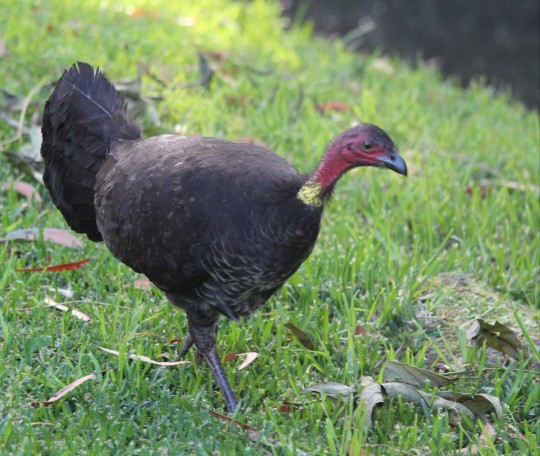
Second Roadtrip bird!
The Australian Brushturkey/gweela (Though we lovingly call them Bushturkeys)
These are a pretty common sight in Aussie caravan parks, I would say a vacation isn't complete if you don't see one.
16 notes
·
View notes
Photo
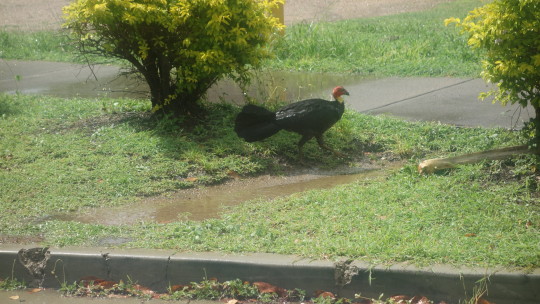

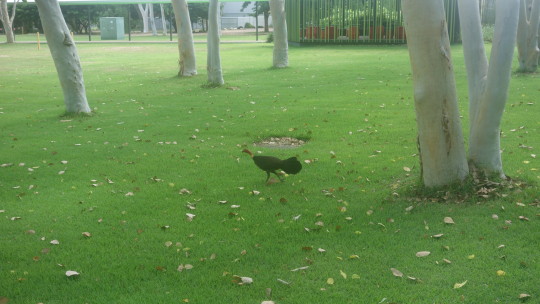
Australian brushturkey on James Cook University’s Townsville campus in Queensland, Australia
7 notes
·
View notes
Text
Days 14-16 of Australia vacation: back in Sydney
On Day 14, we got up early to fly back to Sydney.
There were some nice views out the window of the plane, and we arrived early enough to go to the beach in the afternoon. On our way to the beach, though, we had to make a stop. Brother-in-law had found a Sydney funnelweb spider (which is the world's most venomous kind) in their outdoor shower, so he had captured it in a container to drop off so that the venom could be harvested for use in making the antidote. Eeek!
While we were looking for parking near the beach, I saw what the in-laws called an Australian bush turkey, though eBird calls it an Australian Brushturkey. The beach was pleasant; the others snorkeled and I just enjoyed being in the water for a bit and then did some tidepooling. I think I saw a sea slug! And there were medium-sized lizards called water dragons on some rocks on our way back to the car. It was nice to see some wildlife even in the city!
Unfortunately, right at bedtime I found some "wildlife" in the bedroom: a spider was perched on a corner of a cushion on the bed, and everyone else was already asleep. It was not a venomous spider, but I couldn't sleep with it on the bed, and I didn't want to wake anyone up. It took me a while to gather up all my courage to pick up the cushion from the other end and take it outside. But I did it!
Day 15 was our last day in Australia. We had a bit of a slow start. Sister-in-law had returned to work, and Brother-in-law had a work event in the morning but was joining us for lunch. We took the train (I saw what I think was a female Australasian figbird in a tree near the station) into town and took a little walk along the water in Barangaroo. Then we walked over to the Queen Victoria Building, where we had reserved a table for High Tea service at lunchtime with Brother-in-law; Sister-in-law joined us for a few minutes to say hello on a break from work. The Tea Room is a huge hall with fancy chandeliers, and it feels both silly and luxuriously indulgent to have a meal there. We ate an exquisite array of little sandwiches, pastries, and scones on ornate china, accompanied by tea (decaf Ceylon for me) and sparkling wine.
Afterwards, Wife and I visited the Powerhouse Museum, which had an eclectic mix of exhibitions on various industries, including a section on Indian textiles, a collection of clothing designed by Australian designer Carla Zambatti, and the first train engine to operate in Australia along with 3 restored passenger cars (1st class, 2nd class, and 3rd class).
Then we took the modern commuter rail back, and spent a little while hanging out in a small playground waiting for one of the in-laws to get home since we didn't have a key to the house. While there, I spotted a gray butcherbird, which is a species I hadn't seen yet.
We had a relaxed evening at home. Brother-in-law cooked a scrumptious dinner of risotto, chicken, and broccoli, and we looked at some photos from the trip.
On Day 16, we said goodbye to Sister-in-law before she left for work. We then spent the morning packing; we had to borrow an extra piece of luggage to fit everything. When we were getting ready to leave, I noticed a large bird up in a tree. I unpacked the binoculars to look at it and discovered that it was my first Pied Currawong!
Brother-in-law dropped us off at the airport. He had made arancini (fried risotto balls) from the leftovers from the previous night and put some in a box to bring along, so I had a nice snack on the plane. The flight home was 13 hours long; I dozed for much of it, and it was a good thing I had the arancini because the flight was too turbulent for the flight attendants to serve breakfast before landing! We arrived a few hours before our departure time due to crossing the International Date Line.
All in all, we had a great trip--it really felt like a vacation. I was intrigued to notice how very not interested in the urban sightseeing I felt, but most of the time we weren't in cities, and the scenery, wildlife, and birds were great. Somehow I managed to see at least one new species of bird on each day of the trip!
I don't know if I'll ever get a chance to go back to Tasmania, but if I do, I must find a way to visit Bruny Island for a full-on birdwatching tour.
8 notes
·
View notes
Note
Love your tags about Australia. Also Brushturkeys are like, only in some specific areas of Australia, not the whole place 😂😂😂. I was literally like????? But turns out I don’t live in a state with them, they live along like a strip down the right side from top to 3/4 down. And a bit in Sydney and Brisbane and kangaroo island. You’ve successfully manage to observe a bird that like a ton of south/western Australians probably don’t even know exists, very cool 👍🏻👍🏻
yeah honestly that makes more sense since i was pretty much in and around sydney the entire time. still was kinda wild just seeing them everywhere
2 notes
·
View notes
Text









223) Alectura lathami; Nogal brunatny, Australian brushturkey, Australian brush-turkey, gweela, scrub turkey, bush turkey - gatunek dużego ptaka z rodziny nogali (Megapodiidae). Jest jedynym przedstawicielem rodzaju Alectura. Wyróżniono dwa podgatunki A. lathami:
nogal różowoszyi (A. lathami purpureicollis) – północno-wschodni Queensland
nogal brunatny (A. lathami lathami) – wschodnia Australia.
Nogal brunatny występuje we wschodniej i północno-wschodniej Australii. Najczęściej są to wilgotne lasy, zarośla, ale również zaniedbane ogrody. Można je również znaleźć w pobliżu miast na wschodnim wybrzeżu kontynentu.
Nogal brunatny jest gatunkiem osiadłym zamieszkującym lasy tropikalne bądź lasy strefy umiarkowanej ciepłej. Prowadzi naziemny tryb życia, spędza dni na poszukiwaniu pożywienia na łąkach, pastwiskach oraz w podszycie lasu. Dziób przystosowany jest do dziobania materiału roślinnego, ale może również odżywiać się pokarmem zwierzęcym, np. termitami. Silne nogi oraz dobrze rozwinięte stopy przystosowanie są do grzebania w ziemi w poszukiwaniu pożywienia. Nogal brunatny odżywia się owadami i ich larwami, bezkręgowcami, nasionami, jagodami oraz owocami.
Brak znacznego znaczenia dla gospodarki globalnej. Dla mieszkańców rejonów, na których żyje nogal brunatny, jaja tego gatunku są przysmakiem lokalnym. Zbyt duże zagęszczenie gatunku Alectura lathami powoduje znaczną redukcję masy ściółki leśnej oraz gęstości nasion sadzonek. Nogal brunatny nie jest gatunkiem zagrożonym (według IUCN ma status najmniejszej troski – LC), ale jego liczebność cały czas spada.
0 notes
Text
Sunday, July 29 - Manly and North Head










It was considerably cooler today, as the temperature struggled to get to 60 degrees, and the wind really came up in the afternoon, blowing to around 30 mph. Our plan was to take the ferry over to the north shore town of Manly, which is all the way out on the ocean edge of Sydney harbor. The wind wasn't that strong in the morning when we walked down to Circular Quay to catch the ferry, and we were able to sit outside in the front on the 25 minute trip. Lots to see, and a busy ferry full of folks looking forward to a Sunday outing.
Manly is known mainly for its beaches and the North Head area, which has historically been an area of defense for the Sydney Harbor area. A small neck connects the bay and ferry side to the beach and ocean front, and the main street is a pedestrian mall lined with shops and eateries. Although it was a coolish day, there were quite a few people swimming and snorkeling in the ocean as we started a walk out to the Head. As it was Sunday, there were crowds on the flat esplanade along the sea, and we saw this Pied Cormorant and a so-called "water dragon". The latter is endangered and protected, so seeing one this time of year is a treat. We also saw something called an Australian Brushturkey, which isn't related to our turkey, but has a similar look and habit.
As soon as the path turned from concrete to dirt and started to climb, we left behind most of the people. We passed several lookouts and finally came through an old defense wall and entered a part of the Sydney Harbor National Park, and were suddenly into a much wilder area with lots of flowers and birdsong. For much of the rest of the hike on this side of the head there was a metal mesh walkway, even when it seemed perfectly dry.
The headland here has a long history starting with the aboriginal groups who considered this place a spiritual location, at least until some of the first interactions with Europeans took place. The next use was as a quarantine station, and the old quarantine area is now privately owned and the quarters are now open for overnight stays.
Later there was an active military base here, called North Fort, and many of the buildings remain and have been repurposed since the decommissioning of the fort. There are still parts of the gun emplacements here, as well as an underground plotting room, which was very active during WWII. After the war the area was used for artillery training until 1998. Today the head (except the quarantine area) is managed by a trust, and they have done a great job with interpretation, etc.
For most of our hike, though, we were away from all the car parks and people, and saw few people. We took a short detour route that took us past the "hanging swamp". This was created originally as a source for drinking water for the base by a very small dam, and has since silted up a bit and is full of plants and birds.
At the bayside end of the head there was a parking area and then a circular accessible path with great views out to the ocean, and back to the city. By now the wind was howling, and it was hard to make progress in the windward direction, and we didn't stay long. We had on every piece of warm gear we had brought (not that much considering that most of our trip will be tropical and subtropical) and we were not overheating. We headed back to Manly on a series of trails and roads, completing the 10+km loop, adding in quite a few side diversions. At the end we passed by several beaches with penguin warning signs, but it's not the right time of year, or so we guessed. Bandicoots are endangered, and hence the warning not to drive over any and contribute further to their decline.
Back in Manly we stopped at a fish and chips place, and headed back on the ferry. By now it was almost completely dark, cold and windy, and we took a seat inside. We only did one of several hikes one can do out of Manly, and if we had more time in Sydney we would probably come back and do a hike along the coast back to the west. As it is, we only have one more day, and we will probably go back and explore a little more of the general downtown Sydney area, and see more of the wonderful Botanic Garden. But it was good to get some exercise, and by the time we got back to our hotel, we realized we had probably walked about 11 miles. It was good to get back to our cozy room, enjoy a cold Old Toohey (dark ale) and watch the Olympics from the Australian point of view.
0 notes
Note
I have been collecting birds with common names that have the word 'turkey' in them as I just think they are neat. So far I have
Bush turkey (Alectura lathami) Wild turkey (Meleagris gallopavo) (and all its variations) Ocellated turkey (Meleagris ocellata) Turkey vulture (Cathartes aura) do you know of any others?
The brushturkeys!
These are all the ones I have in my list:
Australian brushturkey - Alectura lathami Black-billed brushturkey - Talegalla fuscirostris Red-billed brushturkey - Talegalla cuvieri Collared brushturkey - Talegalla jobiensis Waigeo brushturkey - Aepypodius bruijnii Wattled brushturkey - Aepypodius arfakianus Ocellated turkey - Meleagris ocellata Wild turkey - Meleagris gallopavo Turkey vulture - Cathartes aura
12 notes
·
View notes
Text
Duplicate Submissions
Alright, here is the list of duplicate birds that were submitted to this poll:
American Robin, Canada Goose, Dovekie, Eurasian Jay, Hoatzin, Blue-bellied Roller, Smew, Hoopoe, Dark-eyed Junco, Painted Bunting, Spoon-billed Sandpiper, Rifleman (Titipoumano), Archeopterix, Hooded Crow, Roseate Spoonbill, Northern Lapwing, European Starling, Steller's Jay, Great Auk, Eclectus Parrot, Ruby-crowned Kinglet, Spotted Towhee, Resplendent Quetzal, Vermilion Flycatcher, Kaua'i O'o, Ivory-billed Woodpecker, Hooded Pitohui, Rainbow Bee-eater, Long-tailed Tit (Shima Enaga), Sunbittern, Varied Thrush, Pied Currawong, Rock Pigeon, Domestic Chicken, Northern Gannet, Diederik Cuckoo, Yellow-headed Picathartes, Temminck's Tragopan, Greater Lophorina, Parotia, Grey Butcherbird, Green Jay, Horned Screamer, Magnificent Frigatebird, Spinifex Pigeon, Gorgeted Puffleg, Zebra Dove, Common House Martin, Swordbill Hummingbird, Greater Roadrunner, Rufous-crested Coquette, Wallcreeper, Racket-tailed Roller, Himalayan Monal, Crested Pigeon, Inaccessible Island Rail, Brown Creeper, Tufted Titmouse, White Wagtail, Bobolink, Shoebill Stork, Australian Brushturkey, black-throated magpie-jay, Greater Blue-eared Starling, spangled cotinga
This list will continue to be updated, but I'm not going to pin it to the top since technically these guys are not the focus of the poll (I just think they're neat :3). The tag placed on pics of these birds is ELIMINATED, as someone asked about tagging them and I figured out how to use the Mass Post Editor >:3
69 notes
·
View notes
Text
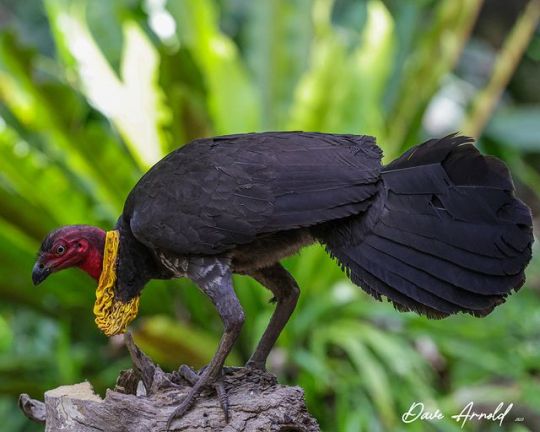
Australian Brushturkey (Alectura lathami), family Megapodidae, order Galliformes, QLD, Australia
Photograph by Dave Arnold
421 notes
·
View notes
